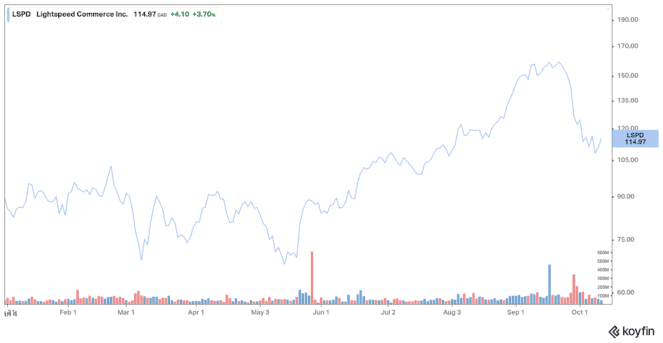Lightspeed Commerce (TSX:LSPD)(NYSE:LSPD) stock has plummeted by nearly 11% after the publication of a report by Spruce Point Capital Management on September 29. Shares have been on a rising trend this past week, but they are still down about 30% from their 52-week high. Canadian investors may wonder what they should do with Lightspeed stock now. Let’s review some of the accusations made against Lightspeed and why fear might have been overblown.
The short-seller made several accusations
Ben Axler, Spruce Point founder and CEO, accused Lightspeed of exaggerating the size of its potential market and of hiding the decline of its activities by chain acquisitions. Among other things, the American short-seller suggested that he was concerned about margins in one of the company’s divisions, that the income was less quality than Lightspeed intended to suggest, and that the key performance indicators had gone downhill.
Mr. Axler accused Lightspeed of changing the items included in the financial indicators revealed in his results in order to hide his difficulties.
Spruce Point believes the competition is increasing against Shopify and Amazon and that Lightspeed will ultimately “lose” the fight, as the stock trades at an “astronomical” multiple of 23 times analysts’ sales forecast for 2022. Mr. Axler estimates that Lightspeed stock could lose between 60% and 80% of its value.
Lightspeed’s response to Spruce Point’s attacks
Lightspeed management counterattacked in a statement, saying that “The report contains numerous important inaccuracies and mischaracterizations which Lightspeed believes are misleading and clearly intended to benefit Spruce Point, which itself has disclosed that it stands to profit in the event that the stock price of Lightspeed declines.”
The Montreal-based company said that “Lightspeed is confident in its governance, financial reporting and business practices. Lightspeed has consistently delivered revenue growth since its initial listing on the Toronto Stock Exchange in March 2019. In the quarter ended June 30, 2021, revenue of $115.9M increased 220% from the prior year quarter with organic software and transaction-based revenue growth of 78%.”
Lightspeed advised investors against making decisions based on Spruce Point’s report.
This is not the first time that Spruce Point has published a critical report on a Canadian company. The firm did the same exercise against Dollarama in 2018 and against Canadian Tire in 2019.
In both cases, the companies involved accused the report of containing inaccuracies. Their actions were corrected immediately but regained lost ground a few months later without the cases being followed up.
The firm has been criticized in the past for being able to short sell some of the stocks in its sights. Shorting a stock allows an investor to get rich when a company’s stock goes down.
The selloff is a buying opportunity
Is there really a reason to be concerned? The company’s latest quarterly reports show strong internal revenue growth. Lightspeed has increased acquisitions to get hold of more market share and new technical skills.
The decline in Lightspeed’s net margins that will result from the growth of its payment solution was already known to investors. Indeed, the Montreal-based company made mention of it in the fourth quarter of fiscal 2019. The lower margins drawn from its IT equipment — such as its terminals provided in its payment solution — are said to be the result of subsidies for equipment forming part of its promotional campaign to launch the activities of its division, the company said during a phone call with its shareholders in the second quarter of 2020.
So, there appears to be no reason to panic. The selloff feels overdone and represents an attractive buying opportunity. Shares have already started to recover. Lightspeed is one of the best Canadian growth stocks to buy.

 2-for1 Sale
2-for1 Sale







